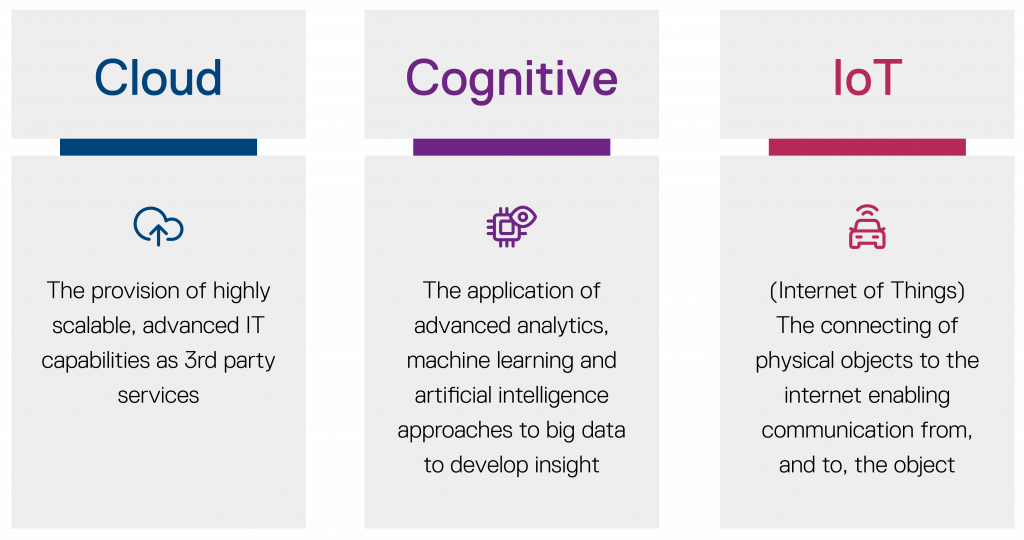Increasing efficiencies and shrinking footprints in the IT industry
When it comes to expanding the circular economy, the IT industry is one of the effort’s greatest enablers — especially when technology provides scalable solutions that drive real value. In fact, global sustainability experts have identified seven distinct types of digital technology that already do or soon will play a critical role in implementing and furthering thousands of circularity initiatives: digital access, cloud, cognitive, blockchain, fast internet, IoT and digital reality. Of those, three are driving particularly impressive advancements across multiple circularity business models:
 However, the computing power that drives these technologies can use an enormous amount of resources — from electricity to power equipment and water for cooling facilities to physical materials and manufacturing impacts. To take leadership and develop credibility as a circular solution, IT-based businesses need to apply their expertise towards developing solutions that not only help other circularity initiatives in other industries, but also “clean their own house.”
However, the computing power that drives these technologies can use an enormous amount of resources — from electricity to power equipment and water for cooling facilities to physical materials and manufacturing impacts. To take leadership and develop credibility as a circular solution, IT-based businesses need to apply their expertise towards developing solutions that not only help other circularity initiatives in other industries, but also “clean their own house.”
Cloud technology holds perhaps the greatest potential for promoting sustainability within the IT industry itself. Virtual servers that operate in the cloud function like physical computing resources, but without additional infrastructure that demands more real estate and more power. The cloud allows organizations to shrink the number of servers, storage, appliances and networking devices that a physical configuration requires. This creates multiple benefits that support a circular economy. For example, virtualization allows for greater utilization of existing resources, which means less equipment and less energy demand. Getting the most from the equipment in use also reduces the amount of resources needed to build new equipment and, at the end of its life, there is also less e-waste — a key environmental responsibility within the technology industry.
“If you think about a company with 1,000 servers in a non-virtualized scenario and they virtualized, that could bring it down to 200 servers — an 80% reduction in IT infrastructure. Now, multiply that globally,” says Nicola Peill-Moelter: Director Sustainability Innovation, Office of the CTO, VMware.
But the impact doesn’t stop there; it’s exponential, expanding beyond just energy and carbon footprints. Having fewer data centers also reduces the burden on the electric grid, possibly avoiding new power plants and the water and emissions impacts they create. Less equipment also means reduced manufacturing waste. Land that was being used to house this infrastructure can be repurposed with sustainability in mind. Finally, fewer coal-fired plant emissions could mean fewer health problems — saving even more precious global resources.
Ultimately, cloud services providers are often in a much better position to manage overall IT equipment utilization, power and cooling efficiency and energy sourcing. This efficiency means fewer servers to perform a set amount of work, maximal energy efficiency and potentially significant reductions in the carbon footprint associated with the computing.
Beyond its sustainability benefits, virtualization also allows for organizations to deploy and adjust digital operations more quickly, with easy scalability, which can reduce costs and boost revenue. And as the role of technology in promoting sustainability continues to increase, a multitude of untapped business opportunities are being created as well.
Another digital element impacting the IT industry’s own circularity practices is cognitive technologies such as Artificial Intelligence (AI) and Machine Learning (ML). Workstations from Dell Technologies include underlying firmware that learns how a person uses their computer, and then edits its own code to optimize performance based on those patterns — which drives down energy use and increases user efficiency. Another AI feature from Dell enables predictive maintenance on computer hardware. Instead of waiting for a part to wear out, an algorithm calculates when a part is likely to fail and sends out a replacement part before any outages happen. Any replaced parts that are still functional or reparable are then refurbished and reused.
“Any time we can get to the point where we’re taking the latencies out of the system, we drive efficiencies and do better for our world,” says Anthony Dina: Director, Big Data & Analytics, Dell Technologies.
Looking forward, it’s important the IT innovations be created not just for innovations’ sake, but instead to develop digital with a purpose. Nicola Peill-Moelter, Director of Sustainability Innovation at VMware, hopes to one day see advances like compostable servers. “The key”, she says with regard to advancements, “is watching — where the world is going, where the customer is going, and where technology is going.”
But the impact of technology reaches far beyond its own industry when it comes to the circular economy. My next blog will explore how technology is enabling sustainability in fields as diverse as farming, medicine, and manufacturing — and what the future holds there.